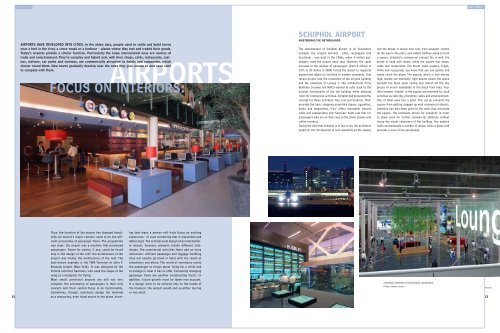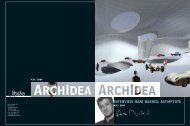INTERVIEW HELMUT JAHN - ArchIdea
INTERVIEW HELMUT JAHN - ArchIdea
INTERVIEW HELMUT JAHN - ArchIdea
You also want an ePaper? Increase the reach of your titles
YUMPU automatically turns print PDFs into web optimized ePapers that Google loves.
AIRPORTS HAVE DEVELOPED INTO CITIES. In the olden days, people used to settle and build towns<br />
near a ford in the river, a cross-roads or a harbour - places where they met and traded their goods.<br />
Today’s airports provide a similar function. Particularly the large international ones are centres of<br />
trade and entertainment. They’re complex and hybrid and, with their shops, cafés, restaurants, casinos,<br />
stations, car parks and cinemas, are commercially attractive<br />
AIRPORTS<br />
to hotels and companies, which<br />
cluster round them. New towns gradually develop near the ones they give access to and even start<br />
to compete with them.<br />
FOCUS ON INTERIORS:<br />
SCHIPHOL AIRPORT<br />
AMSTERDAM, THE NETHERLANDS<br />
The development of Schiphol Airport is an illustrative<br />
example. The original terminal - plain, rectangular and<br />
functional - was built in the 1960s, when 4 million passengers<br />
used the airport each year. However, the rapid<br />
increase in the number of passengers (from 8 million in<br />
1971 to 42 million in 2004) forced the airport to regularly<br />
expand and adjust its facilities to modern standards. One<br />
recent project was the renovation of the original building<br />
and the extension of Lounge 1. The architectural firms<br />
Benthem Crouwel and NACO wanted to refer back to the<br />
original functionality of the old building while allowing<br />
room for commercial activities. Schiphol had presented the<br />
concept for these activities: Run, Fun and Surprise. ‘Run’<br />
provides the basic shopping essentials (liquor, cigarettes,<br />
books and magazines), ‘Fun’ offers enjoyment (mainly<br />
cafés and restaurants) and ‘Surprise’ holds just that for<br />
passengers who are on their way to the plane (casino and<br />
coffee corners).<br />
Taking the view that Schiphol is in fact a city, the architects<br />
opted for the introduction of such elements as the square<br />
and the street. A street now runs from passport control<br />
all the way to the piers, and widens halfway along to form<br />
a square. Schiphol’s commercial concept fits in well: the<br />
street is lined with shops, while the square has shops,<br />
cafés and restaurants. The street looks austere, bright,<br />
white and reassuring: you know that you can quickly and<br />
easily reach the plane. The square, which is two stories<br />
high, stands out markedly: light beams cleave the space<br />
beneath the black steel ceiling and reflect off the tiny<br />
pieces of mirror embedded in the black floor tiles. Four<br />
little wooden ‘islands’ in the square are reserved for such<br />
activities as catering, promotion, sales and entertainment.<br />
One of them even has a pond. This set-up prevents the<br />
square from getting clogged up with commercial objects.<br />
Attention has also been given to the walls that articulate<br />
the square. The architects strove for simplicity in order<br />
to allow room for further commercial additions without<br />
losing the visual coherence of the building. Two austere<br />
walls accommodate a number of shops, while a glass wall<br />
provides a view of the aeroplanes.<br />
Thus, the function of the airport has changed drastiing that many a person still finds flying an exciting<br />
cally. An airport’s major concern used to be the effi- experience - or even something that is impossible and<br />
cient processing of passenger flows. The programme defies logic. The architectural design of an internation-<br />
was clear: the airport was a machine that processed al airport, however, presents totally different chal-<br />
passengers. Room for poetry, if any, could be found lenges. The commercial activities there add an extra<br />
only in the design of the roof: the architecture of the dimension: efficient passenger and luggage handling<br />
airport was mainly the architecture of the roof. The does not exactly go hand in hand with the realm of<br />
best-known example is the TWA Terminal at John F. temptation and allure. The world of commerce wants<br />
Kennedy Airport (New York). It was designed by the the passenger to forget about flying for a while and<br />
Finnish architect Saarinen, who used the shape of the to indulge in what it has to offer. Constantly changing<br />
wing as a metaphor for flying.<br />
passenger flows are another complicating factor. In<br />
Most small, provincial airports are still not very addition, future growth must be taken into account.<br />
complex: the processing of passengers is their only<br />
concern and their central focus is on functionality.<br />
If a design were to be tailored only to the needs of<br />
the moment, the airport would end up either too big<br />
Architects: Benthem Crouwel NACO, Amsterdam<br />
Photos: Jannes Linders<br />
Sometimes, though, architects design the terminal or too small.<br />
12 as a reassuring, even ritual escort to the plane, know-<br />
13<br />
Airports



